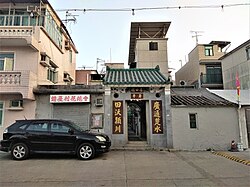


Most of the walled villages of Hong Kong are located in the New Territories.
Contents
- History
- Names
- Conservation
- Features
- Notable walled villages
- Kat Hing Wai
- Tsang Tai Uk
- Sheung Shui Wai
- Fanling Wai
- Nga Tsin Wai Tsuen
- List of walled villages
- North District
- Sha Tin District
- Tai Po District
- Tsuen Wan District
- Tuen Mun District
- Wong Tai Sin District
- Yuen Long District
- Unconfirmed
- Other fenced villages
- Non-walled 'wai'
- See also
- References
- Further reading
- External links




























































































































































